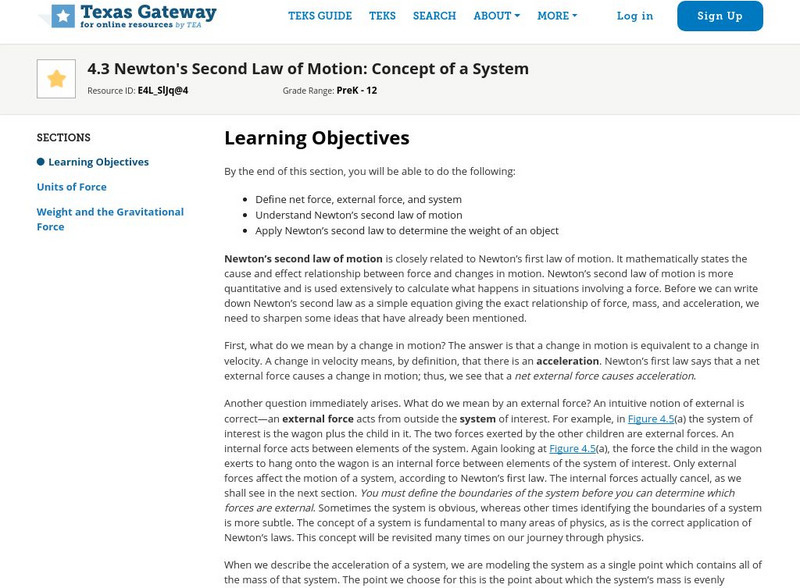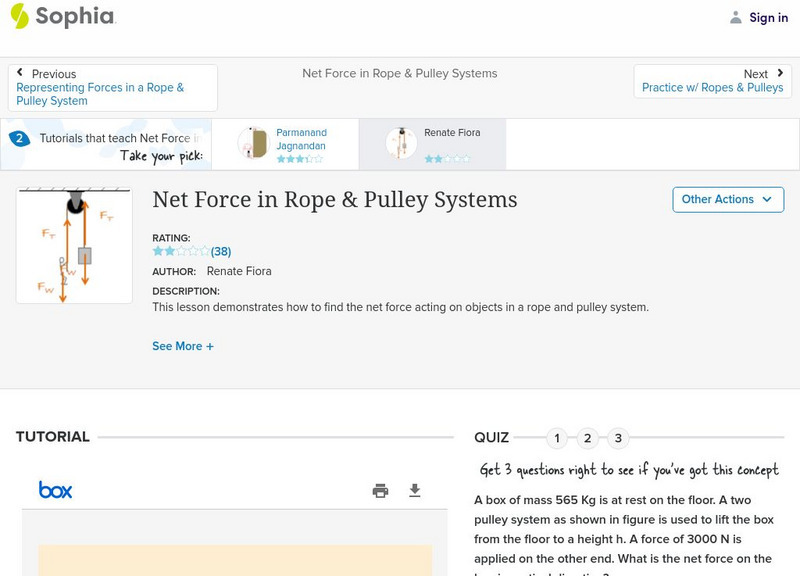Hi, what do you want to do?
Physics Classroom
The Physics Classroom: Newton's Laws: Determining the Net Force
Students combine their understanding of acceleration and the fact that a net force causes an acceleration to determine whether or not a net force exists in several practice situations. After each problem, they are able to check their...
Other
Libros Vivos: Fuerzas en Equilibrio
This site has a simple introduction to equilibrium of force and moment of a force.
Other
Easyphysics: Chapter 5 Motion in Two Dimensions
Learners investigate motion in two dimensions. Some topics examined are two dimensional forces, gravity, and forces in three directions. The resource includes example problems with solutions and a chapter quiz.
Physics Games
Physics Games: Bubble Quod
You're in a bubble and that pointy thing in each level is your only ticket to freedom. Don't let any obstacles stand in your way!
Children's Museum
The Children's Museum of Indianapolis: Curious Scientific Investigators: Flight Adventures
Students will make paper rockets, parachutes, and foam gliders to experience how objects move through the air. Explore topics such as thrust, weight, gravity, force, and lift through fun activities and stories and cutting-edge work done...
Physics Classroom
The Physics Classroom: Newton's Second Law of Motion
Learn more about finding acceleration through the practices found in this lesson. "The process of determining the acceleration of an object demands that the mass and the net force are known." Check out this comprehensive site.
Khan Academy
Khan Academy: What Is Newton's First Law?
Newton's First Law also called the law of inertia is the most important thing to realize about motion. This article offers more information on motion and explains solved problems involving Newton's First Law. Also included is a video...
Texas Education Agency
Texas Gateway: 4.3 Newton's Second Law of Motion: Concept of a System
By the end of this section, you will be able to define net force, external force, and system; understand Newton's second law of motion; and apply Newton's second law to determine the weight of an object.
Curated OER
Zona Land: Components of a Vector
An interactive Java applet where users can rotate a vector about its tail and view the components of that vector. Magnitude of the components is updated on screen as the vector is dragged.
Physics Aviary
Physics Aviary: Practice Problems: Net Torque Level 1
Students must determine the net torque on a wheel. There will be four forces on the wheel and all of them will be at right angles to the radius from the center of the wheel.
Sophia Learning
Sophia: Net Force in Rope & Pulley Systems: Lesson 2
This lesson demonstrates how to find the net force acting on objects in a rope and pulley system. It is 2 of 2 in the series titled "Net Force in Rope & Pulley Systems."
Sophia Learning
Sophia: Net Force in Rope & Pulley Systems: Lesson 1
This lesson demonstrates how to find the net force acting on objects in a rope and pulley system. It is 1 of 2 in the series titled "Net Force in Rope & Pulley Systems."
PBS
Pbs Learning Media: Newton's Triple Play: Baseball Science
In this lesson, students watch a video and animations that relate Isaac Newton's three laws of motion to baseball and apply what they've learned about these laws to another sport or other real-life situation.
Other
Before the Tigers: China's Air Forces in the Struggle Against Japan
A discussion of the Japanese seizure of Manchuria from China and illustrations of fighter Aircraft suggests that this was actually the beginning of World War 2.
Henry J. Sage
Sage American History: The Colonial People at Work
Overview of Colonial work structure in the Thirteen Colonies. The author describes the hierarchy of the labor force and discusses the introduction of slaves. Links to primary source material.
University of Guelph
University of Guelph: Physics Tutorials: What Is Torque?
This site provides an introductory look at torque, the measure of how much a force acting on an object causes that object to rotate. Provides a definition of torque, illustrations, and also a formula to define torque.
Other
Aquatic Nuisance Species Task Force: Habitattitude
Dedicated to aquatic resource conservation, this task force addresses the expansion of harmful plants, fish, and other animals and invasive species
Texas Education Agency
Texas Gateway: 4.2 Newton's First Law of Motion: Inertia
By the end of this section, you will be able to define mass and inertia and to understand Newton's First Law of Motion: There exists an inertial frame of reference such that a body at rest remains at rest, or, if in motion, remains in...
Brigham Young University
Byu: Scott's Official History: American Negro in the World War
This is the full text of a book about the military history of African Americans in World War I. Emmett J. Scott wrote this book in 1919 to detail the experiences of African American soldiers in World War I, covering such topics as...
Brigham Young University
World War I Document Archive: The War With Germany, a Statistical Summary
This lengthy document, written at the end of World War I, is filled with statistics pertaining to every facet imaginable of the United States' participation in World War I. The chapters look at the men who served, the munitions, battles,...
Physics Classroom
The Physics Classroom: Vectors & Projectiles: Vector Addition: Does Order Matter
Watch this short demonstration that focuses on a single question: Does the order in which vectors are added together affect the magnitude or the direction of the resultant?
Children's Museum
The Children's Museum of Indianapolis: Build a Parachute
Students create a parachute to explore how air pushes up against an object and slows it down as it falls.
CK-12 Foundation
Ck 12: Charging Objects
[Free Registration/Login may be required to access all resource tools.] The laws that govern interactions between charged particles are explained, and methods of creating a net charge on an object are described.
Chem4kids
Chem4 Kids: Reaction Rates
This Chem4Kids.com site explores the rate of reactions. Content focuses on forces that change the speed of reactions, and measuring rates.





















